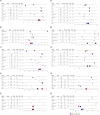Environmental methods for dengue vector control - A systematic review and meta-analysis
- PMID: 31295250
- PMCID: PMC6650086
- DOI: 10.1371/journal.pntd.0007420
Environmental methods for dengue vector control - A systematic review and meta-analysis
Abstract
Background: Vector control remains the primary method to prevent dengue infections. Environmental interventions represent sustainable and safe methods as there are limited risks of environmental contamination and toxicity. The objective of this study is to perform a systematic review and meta-analysis of the effectiveness of the following environmental methods for dengue vector control.
Methodology/principal findings: Following the PRISMA guidelines, a systematic literature search was conducted using the databases PubMed, EMBASE, LILACS, the Cochrane Library and Google Scholar. Quality assessment was done using the CONSORT 2010 checklist. For the meta-analysis the difference-in-differences (DID) and the difference-of-endlines (DOE) were calculated according to the Schmidt-Hunter method for the Breteau index (BI) and the pupae per person index (PPI). Nineteen studies were eligible for the systematic review, sixteen contributed data to the meta-analysis. The following methods were evaluated: (a) container covers with and without insecticides, (b) waste management and clean-up campaigns, and (c) elimination of breeding sites by rendering potential mosquito breeding sites unusable or by eliminating them. Study quality was highest for container covers with insecticides, followed by waste management without direct garbage collection and elimination of breeding places. Both, systematic review and meta-analysis, showed a weak effect of the interventions on larval populations, with no obvious differences between the results of each individual method. For the meta-analysis, both, container covers without insecticides (BI: DID -7.9, DOE -5) and waste management with direct garbage collection (BI: DID -8.83, DOE -6.2) achieved the strongest reductions for the BI, whereas for the PPI results were almost opposite, with container covers with insecticides (PPI: DID -0.83, DOE 0.09) and elimination of breeding places (PPI: DID -0.95, DOE -0.83) showing the strongest effects.
Conclusions: Each of the investigated environmental methods showed some effectiveness in reducing larval and pupal densities of Aedes sp. mosquitoes. However, there is a need for more comparable high-quality studies at an adequate standard to strengthen this evidence.
Conflict of interest statement
The authors have declared that no competing interests exist.
Figures


Similar articles
-
Community-based control of Aedes aegypti by adoption of eco-health methods in Chennai City, India.Pathog Glob Health. 2012 Dec;106(8):488-96. doi: 10.1179/2047773212Y.0000000056. Pathog Glob Health. 2012. PMID: 23318241 Free PMC article. Clinical Trial.
-
Community mobilization and household level waste management for dengue vector control in Gampaha district of Sri Lanka; an intervention study.Pathog Glob Health. 2012 Dec;106(8):479-87. doi: 10.1179/2047773212Y.0000000060. Pathog Glob Health. 2012. PMID: 23318240 Free PMC article. Clinical Trial.
-
Dengue vector management using insecticide treated materials and targeted interventions on productive breeding-sites in Guatemala.BMC Public Health. 2012 Oct 30;12:931. doi: 10.1186/1471-2458-12-931. BMC Public Health. 2012. PMID: 23110515 Free PMC article. Clinical Trial.
-
Interventions for the control of Aedes aegypti in Latin America and the Caribbean: systematic review and meta-analysis.Trop Med Int Health. 2019 May;24(5):530-552. doi: 10.1111/tmi.13217. Epub 2019 Mar 11. Trop Med Int Health. 2019. PMID: 30771267
-
Quantitative modelling for dengue and Aedes mosquitoes in Africa: A systematic review of current approaches and future directions for Early Warning System development.PLoS Negl Trop Dis. 2024 Nov 26;18(11):e0012679. doi: 10.1371/journal.pntd.0012679. eCollection 2024 Nov. PLoS Negl Trop Dis. 2024. PMID: 39591452 Free PMC article.
Cited by
-
Three years of insecticide resistance evolution and associated mechanisms in Aedes aegypti populations of Ouagadougou, Burkina Faso.PLoS Negl Trop Dis. 2024 Dec 2;18(12):e0012138. doi: 10.1371/journal.pntd.0012138. eCollection 2024 Dec. PLoS Negl Trop Dis. 2024. PMID: 39621769 Free PMC article.
-
Dengue and severe dengue with neurological complications: a challenge for prevention and control.Arq Neuropsiquiatr. 2024 Dec;82(12):1-6. doi: 10.1055/s-0044-1792091. Epub 2024 Dec 3. Arq Neuropsiquiatr. 2024. PMID: 39626875 Free PMC article. Review.
-
Reemergence of dengue virus in Bangladesh: Current fatality and the required knowledge.Tzu Chi Med J. 2019 Oct 17;32(3):227-233. doi: 10.4103/tcmj.tcmj_193_19. eCollection 2020 Jul-Sep. Tzu Chi Med J. 2019. PMID: 32955510 Free PMC article. Review.
-
Dengue: A Minireview.Viruses. 2020 Jul 30;12(8):829. doi: 10.3390/v12080829. Viruses. 2020. PMID: 32751561 Free PMC article. Review.
-
Impact of a community-based intervention on Aedes aegypti and its spatial distribution in Ouagadougou, Burkina Faso.Infect Dis Poverty. 2020 Jun 5;9(1):61. doi: 10.1186/s40249-020-00675-6. Infect Dis Poverty. 2020. PMID: 32503665 Free PMC article.
References
-
- World Health Organization. Dengue: Guidelines for Diagnosis Treatment Prevention and Control (New Edition 2009). Geneva: World Health Organization; 2009. Available from: http://www.who.int/tdr/publications/documents/dengue-diagnosis.pdf Cited 04.09.2017. - PubMed
Publication types
MeSH terms
Substances
LinkOut - more resources
Full Text Sources
Medical

